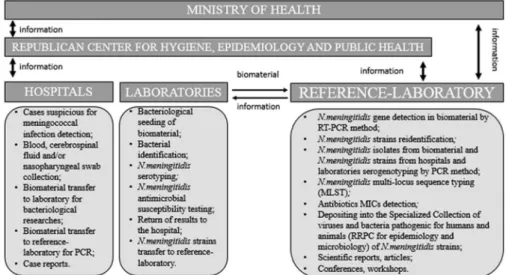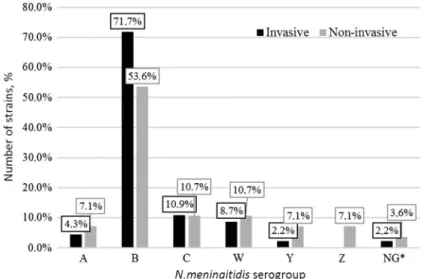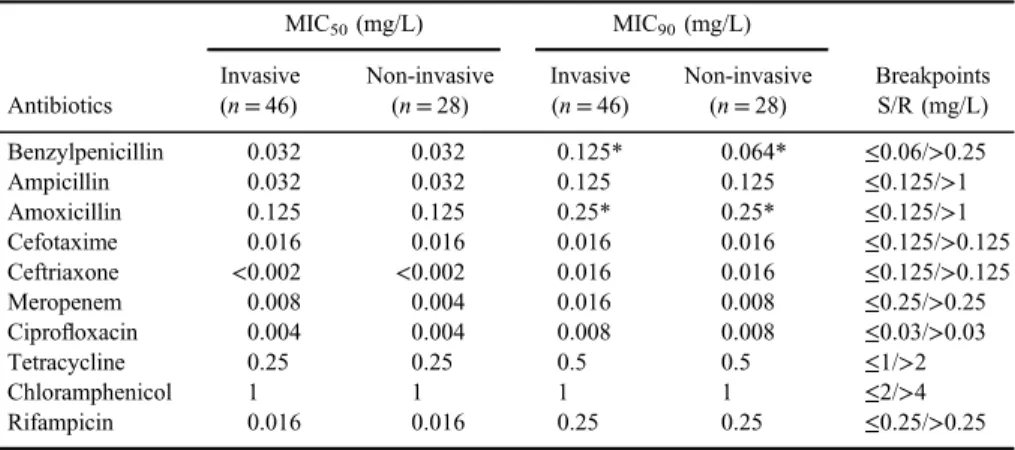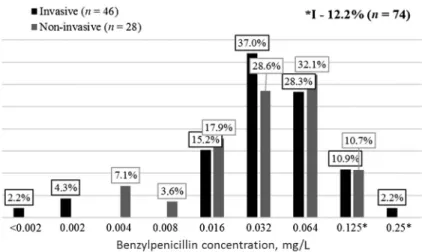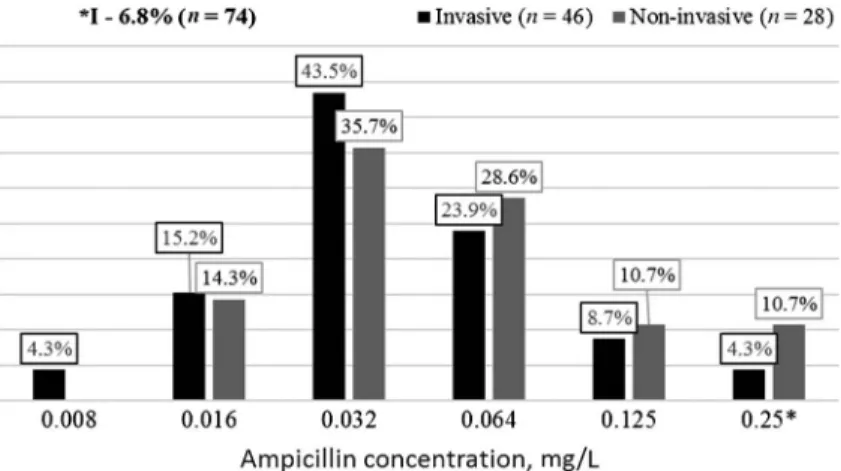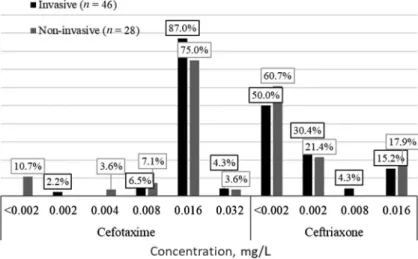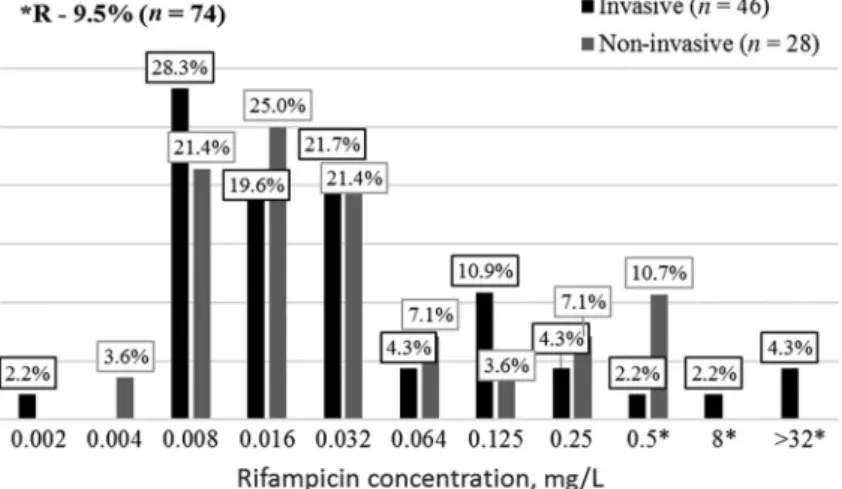SEROGROUP DIVERSITY AND ANTIBIOTIC SUSCEPTIBILITY OF NEISSERIA MENINGITIDIS:
MENINGOCOCCUS INFECTION MONITORING IN BELARUS
HANNA N. KHARKHAL* and LEONID P. TITOV
Laboratory of Clinical and Experimental Microbiology, The Republican Research and Practical Center for Epidemiology and Microbiology, Minsk, Republic of Belarus
(Received: 8 March 2019; accepted: 23 April 2019)
This study performed an epidemiological survey of Neisseria meningitidis strains isolated from patients and from asymptomatic carriers. Altogether, 74 N. meningitidis strains (46 invasive and 28 non-invasive) were isolated between February 2011 and May 2018 in different regions of the Republic of Belarus.
Serogenotyping was carried out by real-time PCR. Minimum inhibitory concentrations (MICs) of antibiotics were determined by broth microdilution and results were interpreted in accordance with EUCAST. The serogroups of N. meningitidiswere determined as follows: serogroup B–65%, C–11%, W–9%, A–5%, Y–4%, and Z and NG –3% each. The MIC50 and MIC90 for benzylpenicillin (0.032/0.064– 0.125 mg/L), ampicillin (0.032/0.125 mg/L), amoxicillin (0.125/0.25 mg/L), cefotax- ime (0.016/0.016 mg/L), ceftriaxone (0.002/0.016 mg/L), ciprofloxacin (0.004/
0.008 mg/L), chloramphenicol (1/1 mg/L), meropenem (0.008/0.008–0.016 mg/L), tetracycline (0.25/0.5 mg/L), and rifampicin (0.016/0.25 mg/L) were established. Strains with intermediate susceptibility for benzylpenicillin (12.3%), ampicillin (6.8%), and amoxicillin (24.7%) have been identified. In this study, we report thefirst rifampicin- resistantN. meningitidisin Belarus.
Keywords: antibiotics, surveillance, meningococcal infection, resistance Introduction
Meningococcal infection is still an urgent problem of the practical public health in the Republic of Belarus [1]. According to the Republican Center for Hygiene, Epidemiology and Public Health data, the notification rate of meningo- coccal infection in 2016 was 0.591 per 100 thousand populations, in 2017, it was 0.665 per 100 thousand populations, and for the period from January 1 to July 31,
*Corresponding author; E-mail:anna‑madlen69@yandex.ru
DOI: 10.1556/030.66.2019.018 First published online July 29, 2019
2018, it was 0.443 per 100 thousand populations. The mortality rate of patients with generalized forms of meningococcal infection remains quite high as in 2016 and 2017; altogether, eight cases were registered that indicates 15% mortality rate.
Due to the low incidence of meningococcal disease in the Republic of Belarus, vaccination against it is not provided in the National Vaccination Calendar. However, because of increase of migration and traveling to countries with a high incidence of meningococcal infections, the meningococcal group B vaccine (recombinant and adsorbed) “Trumenba” (Pfizer HCP Corporation, USA/Pfizer Ireland Pharmaceuticals, Ireland) was registered in the Republic of Belarus in 2018. Vaccine delivery to health care facilities is scheduled for 2019 and will be available for fee.
On the basis of Laboratory of Clinical and Experimental Microbiology (reference laboratory) at the Republican Research and Practical Center for Epidemiology and Microbiology (Minsk, Belarus), the microbiological invasive bacterial diseases (IBD) surveillance (caused by Streptococcus pneumoniae, Neisseria meningitidis, and Haemophilus influenzae) (Ministry of Health order no. 1102 from September 20, 2012) [2,3] and meningococcal infection surveil- lance (Figure1) are held.
Rational antibiotic therapy and chemoprophylaxis allow to prevent complica- tions in patients with meningococcal infection, as well as to reduce the transmission ofN. meningitidisamong carriers.N. meningitidisis sensitive to most antibiotics, but in recent years, the frequency of isolates with intermediate sensitive and
Figure 1.Meningococcal infection surveillance in the Republic of Belarus
resistance has increased in European countries [4–7], America [7–10], Australia [7, 11], and Asia [12]. Strains with reduced susceptibility to penicillins and chloramphenicol that circulated in Belarus were previously described [13].
The aim of this study was to determine the phenotypic susceptibility to antibiotics ofN. meningitidisstrains isolated in Belarussian hospitals and trans- ferred to Republican reference laboratory for the diagnosis of IBD (Laboratory of Clinical and Experimental Microbiology of Republican Research Center for Epidemiology and Microbiology) in 2011–2018.
Antibiotics for this study were selected according to clinical protocols for the diagnosis and treatment of infectious diseases in adults and children (Ministry of Health order no. 484 from June 13, 2006, Appendix 5 [14] and order no. 961 from August 24, 2012 [15], respectively). Antibiotics, which are prescribed for menin- gococcal infections treatment, are benzylpenicillin, chloramphenicol, ceftriaxone, and meropenem; for N. meningitidis elimination in carriers, antibiotics such as rifampicin and ciprofloxacin are used; antibiotics widely used for threatening different infection forms are ampicillin, amoxicillin, cefotaxime, and tetracycline.
Materials and Methods
Altogether, 74N. meningitidisstrains (46 invasive and 28 non-invasive) were isolated during February 2011–May 2018 from different regions of the Republic of Belarus: Minsk–47.3% (20 invasive/15 non-invasive), Brest region–14,7% (9/2), Mogilev region–12.2% (4/5), Grodno region–10.8% (6/2), Vitebsk region–9.5%
(5/2), Minsk region –4.1% (2/1), and Gomel region–1.4% (1 non-invasive).
Invasive strains were isolated from patients aged from 3 months to 62 years (average–8.9 years, interquartile range of 9 months–14 years); female–52%, male– 48%. About 65.2% patients had meningococcemia [21 strains from cerebrospinal fluid (CSF) samples and 9 from blood] and 34.8% had meningitis (14 strains from CSF samples and 2 from blood).
Non-invasive strains were isolated from nasopharyngeal swabs of 28 carriers, who contacted patients with meningococcal invasive infection, aged from 5 months to 59 years (average – 26.7 years, interquartile range of 3–48 years); female–44%, male – 56%.
Laboratory diagnosis
Bacterial cultivation was carried out using GC-agar (Conda, Spain) with 20% horse serum addition (Himmedsintez, Republic of Belarus, Minsk) and commercial supplement VCNT (HiMedia, India) in a CO2incubator at 37 °C and 5%–10% CO2for 20–24 h.
Additional molecular reidentification was carried out by RT-PCR with superoxide dismutaseC (sodC) gene detection according to WHO and CDC (Atlanta, USA) recommendations [16]. RT-PCR was held on Rotor-gene 3000 (Corbett Research, Australia) with running parameters: one cycle on 95 °C for 10 min, then 45 cycles on 95 °C for 15 s, and on 60 °C for 60 s withfluorescence detection on 6-carboxyfluorescein channel. DNA extracted by previously described boiling method [16].
Minimum inhibitory concentrations (MICs) were determined by broth microdilution method [Mueller-Hinton broth (Fluka Analytical, Germany) and 20% horse serum (Himmedsintez)], or using E-tests (Biomerieux, France). MICs of benzylpenicillin, ampicillin, amoxicillin, cefotaxime, ceftriaxone, meropenem, ciprofloxacin, tetracycline, chloramphenicol, and rifampicin were determined in the range<0.002–>32 mg/L. Strains obtained as part of Microbiology Quality Assessment forH. influenzae,N. meningitidis, andS. pneumoniaeidentification, susceptibility, and typing (WHO and UK NEQAS, UK) was used as controls.
The results were interpreted using EUCAST breakpoint tables version 8.0 valid from January 1, 2018. MIC50and MIC90(antibiotics concentrations inhibiting growth of 50% and 90% of the strains, respectively) were determined by ordered array method. Microbiological susceptibility to benzylpenicillin, cefotaxime, cip- rofloxacin, and chloramphenicol was determined by comparing MIC values with epidemiological cut-off value (ECOFFV;https://mic.eucast.org/Eucast2/).
Serogenotype of N. meningitidisstrains was determined by RT-PCR with synD(serogroup B),synE(serogroup C),sacB(serogroup A),xcbB(serogroupХ), synG(serogroup W), andsynF(serogroup Y) genes detection according to WHO and CDC recommendations [16] and by conventional PCR withlcbB(serogroup L), capZC (serogroup Z), and cap29EH (serogroup E) genes electrophoresis detection in agarose gel [17].
Data entry, statistical processing, and analysis were performed using Microsoft Office version 13.0 software.
Results
N. meningitidisserogroup distribution
During this study, serogroup distribution of invasive and non-invasive N. meningitidisstrains was established (Figure 2).
Invasive and non-invasiveN. meningitidisstrains were presented by differ- ent serogroups with dominant serogroup B among invasive strains in 72% cases (33/46) and non-invasive – 53.6% (15/28). Serogroup С distribution was 11%
(5/46 invasive and 3/28 non-invasive). Serogroups A, W, and Y were also in both groups, but were more common among bacterial carriers. Serogroup Z was only detected among non-invasive strains (2/28). Two strains have not been established as serogroups A, B, C, E, L, W, X, Y, or Z and were marked as non-groupable (NG).
N. meningitidisstrains susceptibility/resistance to antibiotics
MIC50 and MIC90 of 10 antibiotics and clinical breakpoints (EUCAST 2018, www.eucast.org) are presented in Table I.
As TableIshows, MIC50for all antibiotics except meropenem was the same among invasive and non-invasive strains and interpreted as susceptible. Mero- penem MIC50for invasive strains was higher than for non-invasive, but both were susceptible. Differences in MIC90for benzylpenicillin and meropenem were found with higher values among invasive strains.
Antibiotic susceptibility to benzylpenicillin, cefotaxime, ciprofloxacin, and chloramphenicol was determined by comparing MIC values with ECOFFV, which separate bacterial population into susceptible“wild”strains and resistant–strains with acquired resistance mechanisms. This data is used for epidemiological antimicrobial resistance surveillance.
Figure 2.N. meningitidisserogroups distribution (%).Note:*NG marked strains whose serogroup has not been established (not serogroups A, B, C, E, L, W, X, Y, and Z)
Phenotypical N. meningitidis strains’ characteristics, separated to “wild”
population and population with resistance mechanisms, are shown in TableII. All strains are susceptible to benzylpenicillin, ciprofloxacin, and chloramphenicol, but two invasive and one non-invasive strains had cefotaxime MICs that shows acquired resistance mechanisms, but clinically interpreted as susceptible. Epide- miological cut-off points cannot be used to determine local resistance levels because they are calculated using aggregate data of MIC distribution from different sources, geographic areas of the world and periods of time; therefore, they cannot be used to determine local resistance levels.
Benzylpenicillin
According to clinical protocol for diagnosis and treatment of infectious diseases in adults and children [14,15], benzylpenicillin is the drug of choice for meningococcal infections treatment. Figure3shows meningococci susceptibility to different benzylpenicillin concentrations. Determined that more than 87% of all strains were susceptible to benzylpenicillin, but MICs of more than 60%
strains of both groups were 0.032–0.064 mg/L, which is close to border between clinically susceptible and intermediate susceptible. Among invasive strains, MIC90 is higher than among non-invasive and is interpreted as intermediate (0.125 and 0.064 mg/L, respectively). Among strains with intermediate suscep- tibility to benzylpenicillin (n=9), the dominant serogroup was B (7/9) and serogroup C was detected too (2/9).
Table I.MIC50and MIC90values ofN. meningitidisstrains
Antibiotics
MIC50(mg/L) MIC90(mg/L)
Breakpoints S/R (mg/L) Invasive
(n=46)
Non-invasive (n=28)
Invasive (n=46)
Non-invasive (n=28)
Benzylpenicillin 0.032 0.032 0.125* 0.064* ≤0.06/>0.25
Ampicillin 0.032 0.032 0.125 0.125 ≤0.125/>1
Amoxicillin 0.125 0.125 0.25* 0.25* ≤0.125/>1
Cefotaxime 0.016 0.016 0.016 0.016 ≤0.125/>0.125
Ceftriaxone <0.002 <0.002 0.016 0.016 ≤0.125/>0.125
Meropenem 0.008 0.004 0.016 0.008 ≤0.25/>0.25
Ciprofloxacin 0.004 0.004 0.008 0.008 ≤0.03/>0.03
Tetracycline 0.25 0.25 0.5 0.5 ≤1/>2
Chloramphenicol 1 1 1 1 ≤2/>4
Rifampicin 0.016 0.016 0.25 0.25 ≤0.25/>0.25
Note:S: susceptible; R: resistant; MIC: minimum inhibitory concentration.
*Marked MICs, interpreted as intermediate.
TableII.N.meningitidisstrainsantibioticsusceptibility Antibiotics
MICs(mg/L) <0.0020.0020.0040.0080.0160.0320.0640.1250.250.512 Invasivestrains(n=46) Benzylpenicillin12––7171351–a–a–a Cefotaxime–1–3402–a –a –a –a –a –a Ciprofloxacin–231103––a–a–a–a–a–a Chloramphenicol–––111112103– Non-invasivestrains(n=28) Benzylpenicillin––215893––a–a–a Cefotaxime3–12211a–a–a–a–a–a–a Ciprofloxacin37135––a –a –a –a –a –a –a Chloramphenicol––––––1129132 Note:MIC:minimuminhibitoryconcentration. aEpidemiologicalcut-offvalue.
Chloramphenicol
In case of patient’s intolerance to β-lactams, chloramphenicol is used for meningococcal infection treatment [14, 15]. All N. meningitidisstrains (n=74) were susceptible to chloramphenicol, but strains with MIC border value (2 mg/L) were detected–6.5% among invasive strains and 7.1% among non-invasive. All strains with MIC=2 mg/L wereN. meningitidis serogroup B.
Ampicillin
Ampicillin is an antibiotic, which is widespread for treating different infectious diseases in hospitals and outpatient department. Figure 4 shows N. meningitidis strains susceptibility to different ampicillin concentrations. As seen in Figure 4, the dominant concentration in both groups was 0.032 mg/L (43.5% – invasive strains and 35.7% – non-invasive strains). Determined that 6.8% of all strains were intermediate susceptible to ampicillin, and among non- invasive strains, the percentage is higher–10.7% against 4.3% among invasive strains. All strains with intermediate susceptibility wereN. meningitidisB.
Amoxicillin
Despite the fact that amoxicillin is not used for meningococcal infections treatment, this antibiotic is widespread for treating different infectious diseases.
Figure 3.N. meningitidisstrains susceptibility to benzylpenicillin
Figure 5 shows N. meningitidis strains susceptibility to different amoxicillin concentrations. It is noted that 69.6% of invasive N. meningitidis strains and 85.7% of non-invasive strains were susceptible to amoxicillin. Fourteen strains had intermediate susceptibility. Among 14 invasive strains with intermediate susceptibility, the dominant serogroup is B (72%, 10/14); serogroups W (14%, 2/14), A (7%, 1/14), and C (7%, 1/14) were also detected. Almost the same serogroups were detected among four non-invasive strains: serogroup B (2/4), A (1/4), and C (1/4).
Figure 4.N. meningitidisstrains susceptibility to ampicillin
Figure 5.N. meningitidisstrains susceptibility to amoxicillin
Third-generation cephalosporines
In accordance with valid clinical protocols, third-generation cephalospor- ines are used to treat acute meningococcemia and Waterhouse–Friederiksen syndrome in adults [14] and meningococcal meningitis and unspecified meningococcal infection in children [15]. Figure6showsN. meningitidisstrains susceptibility to different cefotaxime and ceftriaxone concentrations. All N. meningitidisstrains were clinically susceptible to the third-generation cepha- losporines. However, two invasive strains (serogroups B and W) and one non- invasive strain (serogroup B) were interpreted as microbiologically resistant to cefotaxime (MIC=0.032 mg/L). It means that they probably had acquired resistance mechanisms.
Meropenem
In accordance with valid clinical protocols, meropenem is also used as reserve antibiotic for treating adults with Waterhouse–Friederiksen syndrome or meningococcal meningitis [14]. In case of ceftriaxone intolerance in children, meropenem is used for treating meningococcal heart disease (A39.5) [15].
Meningococcal strains’ resistance level to meropenem is low– MIC90 is 0.016 and 0.008 mg/L for invasive and non-invasive strains, respectively.
Figure 6.N. meningitidisstrains susceptibility to third-generation cephalosporines
Ciprofloxacin
It was established that all strains were clinically and microbiologically susceptible to ciprofloxacin. For invasive meningococci, MIC90 is higher than for non-invasive strains –0.008 and 0.004 mg/L, respectively. Ciprofloxacin is not used to treat meningococcal infection now, but to prevent secondary infection [14,15,18].
Tetracycline
All invasive and non-invasive N. meningitidis strains (n=74) were clini- cally susceptible to tetracycline, but strains close to breakpoint concentration (MIC=1 mg/L) were also detected –6.5% among invasive meningococci and 3.4% among non-invasive.
Rifampicin
Rifampicin is known as an anti-tuberculosis drug and not a widespread antibiotic for other infections, but it can be used for meningitis prophylaxis [18].
Figure 7 shows N. meningitidis strains susceptibility to different rifampicin concentrations.
Clinically resistant to rifampicin strains were identified among invasive meningococci – 8.7% (4/46) and non-invasive – 10.7% (3/28). Among
Figure 7.N. meningitidisstrains susceptibility to rifampicin
invasive-resistant meningococci three strains, serogroup B was isolated in Minsk, Iwie (Grodno region) and Pinsk (Brest region). Strain from Pinsk was also intermediate susceptible to amoxicillin. Invasive-resistantN. meningitidis strain from Luban (Minsk region) was identified as NG (not A, B, C, E, L, W, X, Y, and Z). Among non-invasive strains, resistant meningococci were isolated in Brest–serogroup B, Vitebsk–serogroup B, and Orsha–serogroup Y (Vitebsk region). Strain from Vitebsk was also intermediate susceptible to benzylpenicillin.
Discussion
Meningococcal infection surveillance is prerequisite for improving the treatment efficiency as well as to prevent spread of infection among carriers and the transition to generalized forms, such as meningitis, meningococcemia, and endocarditis. Meningococcal infection surveillance is currently available in Belarus, but it is needed to be improved first with the expansion of the geographical coverage of the support bases (hospitals and laboratories); second, biomaterial and isolates transfer to reference laboratory; third, relationship between all members of surveillance system improvement. Antimicrobial resis- tance surveillance in general andN. meningitidisantimicrobial resistance surveil- lance in particular are the obligatory condition of effective infectious control on local, regional, and republican levels [1,13].
PPhenotypic susceptibility/resistance of invasive and non-invasive meningo- cocci to penicillins (benzylpenicillin, amoxicillin, and ampicillin), third-generation cephalosporines (cefotaxime and ceftriaxone), carbapenems (meropenem), tetra- cyclines (tetracycline), fluoroquinolones (ciprofloxacin), amphenicols (chloram- phenicol), and rifampicins (rifampicin) shows that there areN. meningitidisstrains with intermediate susceptibility to penicillins and resistance to rifampicin circulating in Belarus.
In accordance with valid clinical protocols [14,15], benzylpenicillin is still used for meningococcal infection treatment. Among all Belarussian N. meningitidisstrains, 12.2% were intermediate susceptible to benzylpenicillin (MIC=0.125–0.25 mg/L) with 13% in invasive meningococci group and 10.7%
in non-invasive group. Strains with intermediate susceptibility toβ-lactams were found in other countries all over the world [5,12,19,20]. In Belgium, e.g., the level of non-susceptible to penicillin isolates was 15.3% with dominant ser- ogroup B. In Russia, the level of non-susceptibility was decreased from 11% in 2006–2011 to 2% in 2012–2015 [21].
The highest level of intermediate susceptibility inN. meningitidisstrains was to aminopenicillins–to ampicillin (4.3% among invasive strains and 10.7% among non-invasive) and amoxicillin (30.4% invasive and 14.3% non-invasive), which indicates the widespread use of these antibiotics in clinical and prophylactic practice.
However, low meningococci susceptibility to ampicillin was also previously detected in Belarus [13]. The percentage of intermediate susceptible strains decreased from 53% in 2010 to 6.8% with the significant decrease of MIC90 value– 0.064 mg/L in comparison with>0.25 mg/L in 2010.
Serogroup distribution of N. meningitidisstrains with intermediate suscep- tibility to penicillins is as follows: serogroup B–74.4%, serogroup C–10.3%, serogroup A and W–5.1% each, and other –5.1%.
The data about unsusceptible to ciprofloxacin isolates in the counties of North America were reported [9, 10]. However, all the studied Belarusian N. meningitidisstrains were susceptible to this antibiotic; MIC90among invasive and non-invasive strains is 0.008 mg/L.
During this study, 9.5% ofN. meningitidisstrains were resistant to rifampi- cin (MIC>0.25 mg/L): 8.7% among invasive meningococci and 10.7% among non-invasive. There are publications about rifampicin-resistant meningococci in European countries (Hungary, Germany, France, and Switzerland) [4, 7, 21], in America (Canada, USA, Uruguay, and Brazil) [5, 9], and in Australia [7]. In Moscow, resistant meningococci serogroup B were also detected [22]. Previously, resistant to rifampicin meningococci has not been described in Belarus [13];
however, the MIC50and MIC90levels have not changed since 2010 and are 0.016 and 0.25 mg/L, respectively.
All studied strains were susceptible to third-generation cephalosporines.
However, in comparison with Belarussian data from 2010, MIC90 increased from 0.008 mg/L in 2010 to 0.016 mg/L for both cefotaxime and ceftriaxone [13]. On the other hand, MIC50 and MIC90 to meropenem significantly decreased. Thus, MIC90 to meropenem >0.03 mg/L in 2010 decreased to 0.016 mg/L among invasiveN. meningitidisstrains and to 0.008 mg/L among non-invasive [13].
In this study, no unsusceptible to chloramphenicolN. meningitidis strains were detected in Belarus (MIC90=1 mg/L); whereas the level intermediate susceptible strains were 54% earlier [13], so there is a decrease of such isolates circulation.
Thus, among antibiotics that are used for meningococcal infection treatment, N. meningitidis strains are strongly susceptible to chloramphenicol (MIC90= 1 mg/L), ceftriaxone (MIC90=0.016 mg/L), meropenem (MIC90=0.016 mg/L among invasive strains and MIC90=0.008 mg/L among non-invasive), and
benzylpenicillin (MIC90=0.064 mg/L among non-invasive), whereas invasive strains were intermediate susceptible to benzylpenicillin (MIC90=0.125 mg/L).
Among antibiotics that are used for meningococci elimination in carriers, ciprofloxacin was clinically high susceptible in vitro (MIC90=0.008 mg/L), whereas resistant to rifampicin strains was detected; hence MIC90 is higher.
Antibiotic resistance surveillance must be the part of meningococcal infec- tion surveillance as the reasonable and scientifically based element of meningo- coccal infection treatment and prevention improvement. Molecular surveillance as a part of meningococcal infection surveillance is also needed, especially after antimeningococcal vaccination introduction.
Conflict of Interest
The authors declare no conflict of interests regarding the publication of this paper.
References
1. Titov, L. P.: Meningococcal infection: Current state of problem. Healthcare (Belarus) [Zdravookhranenie]12, 15–23 (2010) (in Russian).
2. On the establishment of the Republican Reference Laboratory for the Diagnosis of Invasive Bacterial Diseases: Order of the Ministry of Health of the Republic of Belarus of March 25, 2013.379, 1–9 (2013) (in Russian).
3. On the implementation of Sentinel Surveillance for Invasive Bacterial Diseases in the Republic of Belarus: Order of the Ministry of Health of the Republic of Belarus of September 20, 2012,1102, 1–8 (2012) (in Russian).
4. Toth, A., Berta, B., Tirczka, T., Jekkel, C., Abraham, A., Prohaszka, Z., Bognar, Z., Erdosi, T.: First description of a rifampicin-resistant Neisseria meningitidis serogroup Y strain causing recurrent invasive meningococcal disease in Hungary. Acta Microbiol Immunol Hung64, 1–7 (2017).
5. Bertrand, S., Carion, F., Wintjens, R., Mathys, V., Vanhoof, R.: Evolutionary changes in antimicrobial resistance of invasiveNeisseria meningitidisisolates in Belgium from 2000 to 2010: Increasing prevalence of penicillin nonsusceptibility. Antimicrob Agents Chemother 56, 2268–2272 (2012).
6. Skoczy´nska, A, Waśko, I., Kuch, A., Kadłubowski, M., Gołębiewska, A., Foryś, M., Markowska, M., Ronkiewicz, P., Wasiak, K., Kozi´nska, A., Matynia, B., Hryniewicz, W.: A decade of invasive meningococcal disease surveillance in Poland. PLoS One 8, e71943 (2013).
7. Delaune, D., Andriamanantena, D., Mérens, A., Viant, E., Aoun, O., Ceppa, F., Taha, M. K., Rapp, C.: Management of a rifampicin-resistant meningococcal infection in a teenager. Infection41, 705–708 (2013).
8. Gorla, M. C., de Paiva, M. V., Salgueiro, V. C., Lemos, A. P., Brandão, A. P., Vázquez, J. A., Brandileone, M. C.: Antimicrobial susceptibility ofNeisseria meningitidisstrains
isolated from meningitis cases in Brazil from 2006 to 2008. Enferm Infecc Microbiol Clin 29, 85–89 (2011).
9. Tsang, R. S., Law, D. K., Deng, S., Hoang, L.: Ciprofloxacin-resistantNeisseria meningi- tidisin Canada: Likely imported strains. Can J Microbiol63, 265–268 (2017).
10. Harcourt, B. H., Anderson, R. D., Wu, H. M., Cohn, A. C., MacNeil, J. R., Taylor, T. H., Wang, X., Clark, T. A., Messonnier, N. E., Mayer, L. W.: Population-based surveillance of Neisseria meningitidisantimicrobial resistance in the United States. Open Forum Infect Dis 2, 117 (2015).
11. Peak, I. R., Jennings, C. D., Jen, F. E., Jennings, M. P.: Role ofNeisseria meningitidisPorA and PorB expression in antimicrobial susceptibility. Antimicrob Agents Chemother58, 614–616 (2014).
12. Tripathi, V., Tripathi, P., Srivastava, N., Gupta, D.: In silico analysis of different generation βlactams antibiotics with penicillin binding protein-2 ofNeisseria meningitidisfor curing meningococcal disease. Interdiscip Sci6, 259–270 (2014).
13. Glazkova, S. E., Lebedev, F. A., Titov, L. P.:Neisseria meningitidisstrains sensitivity to antibiotics. Healthcare (Belarus) [Zdravookhranenie]10, 26–31 (2011) (in Russian).
14. Clinical protocols for the diagnosis and treatment of the adult population with infectious and parasitic diseases: Appendix 5 to the order of the Ministry of Health of the Republic of Belarus of June 13, 2006.484, 271–442 (2006) (in Russian).
15. On approval of the clinical protocol and declaring as invalid a separate structural element of the order of the Ministry of Health of the Republic of Belarus of June 13, 2006 No. 484:
Order of the Ministry of Health of the Republic of Belarus of August 24, 2012.961, 1–138 (2006) (in Russian).
16. World Health Organization & Centers for Disease Control and Prevention (U.S.): Labora- tory methods for the diagnosis of meningitis caused by Neisseria meningitidis, Strepto- coccus pneumoniae, and Haemophilus influenza: WHO manual, WHO/IVB.11.09, 2nd Edition. World Health Organization, Geneva, 2011, p. 311. Available athttp://www.who.
int/iris/handle/10665/70765
17. Zhu, H., Wang, Q., Wen, L., Xu, J., Shao, Z., Chen, M., Chen, M., Reeves, P. R., Cao, B., Wang, L.: Development of a multiplex PCR assay for detection and genogrouping of Neisseria meningitidis. J Clin Microbiol50, 46–51 (2012).
18. European Committee on Antimicrobial Susceptibility Testing, European Society of Mi- crobiology and Infectious Diseases: Breakpoint tables for interpretation of MICs and zone diameters. Version 8.1, 2018. Available athttp://www.eucast.org/clinical_breakpoints 19. Olesky, M., Zhao, S., Rosenberg, R. L., Nicholas, R. A.: Porin-mediated antibiotic
resistance inNeisseria gonorrhoeae: Ion, solute and antibiotic permeation through PIB proteins with penB mutations. J Bacteriol188, 2300–2308 (2006).
20. Tzeng, Y. L., Stephens, D. S.: Antimicrobial peptide resistance inNeisseria meningitides.
Biochim Biophys Acta1848, 3026–3031 (2015).
21. Mounchetrou Njoya, I., Deghmane, A. E., Taha, M. K., Isnard, H., Parent du Châtelet, I.: A cluster of meningococcal disease caused by rifampicin-resistant C meningococci in France, April 2012. Euro Surveill17, 20254 (2012).
22. Koroleva, M. A., Koroleva, I. S., Zakroeva, I. M., Gruber, I. M.: The susceptibility of meningococci to the antimicrobial agents in Moscow, 2006–2015. Epidemiol Vaccinal Prev [Èpidemiologiâ i vakcinoprofilaktika]88, 7–14 (2016) (in Russian).
